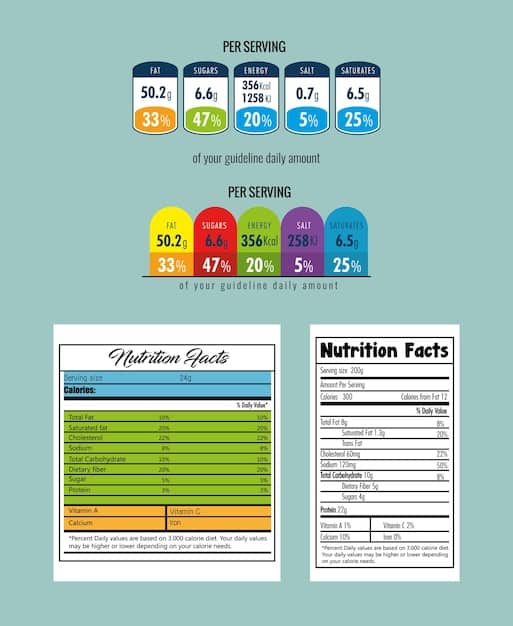Decoding Food Labels: Your Guide to Healthy Choices

Decoding Food Labels: Understanding Nutrition Facts and Making Informed Choices empowers consumers to make informed food choices by demystifying labels, highlighting key information, and promoting a healthier lifestyle through mindful eating habits.
Navigating the grocery store can feel like deciphering a secret code with all those food labels staring back at you. But what if understanding these labels could unlock a healthier, more informed you? Decoding Food Labels: Understanding Nutrition Facts and Making Informed Choices equips you with the knowledge to navigate this complex world.
Understanding the Basics of Food Labels
Food labels are designed to provide consumers with essential information about the nutritional content and ingredients of packaged foods. They’re your roadmap to making smart choices, but only if you know how to read them.
What is the Nutrition Facts Label?
The Nutrition Facts label is a standardized label required on most packaged foods. It provides a breakdown of the nutrients in the product, including calories, fat, carbohydrates, protein, vitamins, and minerals.
Serving Size: The Foundation of Understanding
Pay close attention to the serving size listed at the top of the Nutrition Facts label. All the information that follows is based on that specific serving size. If you consume more than the serving size, you’ll need to adjust the nutrient values accordingly.
- Consult the Label: Always review it before eating.
- Be Realistic: Adjust portions as required.
- Comparative Analysis: Evaluate against recommended intake.

Understanding these foundational elements of food labels is critical. Armed with this knowledge, you’re better placed to make choices aligned with your dietary needs and goals, setting you on the path to a healthier lifestyle.
Calories: The Energy Equation
Calories provide a measure of the energy you get from a serving of food. Understanding the calorie content of foods is essential for maintaining a healthy weight and overall well-being.
What is a Calorie?
A calorie is a unit of energy. Your body uses calories from food to fuel its various functions, such as breathing, moving, and thinking. Consuming more calories than your body needs can lead to weight gain, while consuming too few can lead to weight loss.
Understanding Calories per Serving
The Nutrition Facts label lists the number of calories per serving. This information can help you gauge whether a food is a good choice for your overall calorie intake. It’s important to note that the calorie amount is based on the specified serving size.
Balancing your daily calorie intake with your activity level helps maintaining a healthy lifestyle. Choose wisely for optimal health.
Fats: Friend or Foe?
Fats often get a bad rap, but they are an essential nutrient that plays a vital role in your health. The key is understanding the different types of fats and choosing them wisely.
Types of Fats: Saturated, Unsaturated, and Trans Fats
The Nutrition Facts label breaks down the total fat content into different types: saturated fat, unsaturated fat (including monounsaturated and polyunsaturated fats), and trans fat. Saturated and trans fats are generally considered unhealthy, while unsaturated fats are considered healthy.
Decoding Fat Content on the Label
Aim to limit your intake of saturated and trans fats as much as possible. Focus on incorporating healthy unsaturated fats into your diet, which can be found in foods like avocados, nuts, seeds, and olive oil.
- Read Carefully: Distinguish kinds of fats.
- Limit Saturated: Reduce intake of unhealthy fats.
- Focus on Healthy: Prioritize omega-3 and omega-6.
Making better fat choices, such as going for avocados and nuts instead of processed foods, can greatly enhance your overall health.
Sugars: The Sweet Truth
Sugar is a type of carbohydrate that provides energy to your body. However, excessive sugar intake can lead to a variety of health problems, including weight gain, type 2 diabetes, and heart disease.
Understanding Total Sugars and Added Sugars
The Nutrition Facts label lists both total sugars and added sugars. Total sugars include both naturally occurring sugars (like those found in fruits and milk) and added sugars (like those added during processing). Added sugars provide empty calories and should be limited in your diet.
Tips for Reducing Sugar Intake
Be mindful of the amount of added sugars in packaged foods. Look for products with little or no added sugars, and opt for natural sweeteners like fruit instead of refined sugars.

By understanding which sugars are naturally occurring and which are added, you’re empowered to control your sugar intake. Small adjustments can make a big difference in your health and wellness.
Sodium: The Salt Shakedown
Sodium is an essential mineral that helps regulate fluid balance in the body. However, excessive sodium intake can lead to high blood pressure and increase your risk of heart disease and stroke.
Understanding Sodium Content on the Label
The Nutrition Facts label lists the amount of sodium per serving. Most Americans consume too much sodium, so it’s important to be mindful of your sodium intake.
Tips for Reducing Sodium Intake
Choose low-sodium or reduced-sodium options whenever possible. Avoid adding extra salt to your food, and use herbs and spices to flavor your meals instead.
Reducing your sodium intake can have profound benefits for your heart health. The food label is a crucial tool for making informed, lower-sodium choices.
Putting It All Together: Making Informed Choices
Decoding Food Labels: Understanding Nutrition Facts and Making Informed Choices is becoming easier but putting all this knowledge together is the ultimate key to making informed choices for a healthier life.
Comparing Products Side-by-Side
Use the Nutrition Facts label to compare similar products and choose the one that is lower in calories, unhealthy fats, added sugars, and sodium. Look for products that are higher in fiber, vitamins, and minerals.
Creating a Balanced Diet
Use the information on food labels to help you create a balanced diet that meets your nutritional needs. Aim for a variety of nutrient-rich foods from all food groups.
Ultimately, understanding food labels is a powerful tool for optimizing your health. With practice, you’ll become adept at decoding labels and making choices that support your well-being.
| Key Point | Brief Description |
|---|---|
| 🧐 Serving Size | Information is based on this amount; adjust accordingly. |
| 🔥 Calories | Energy content; balance with activity for weight management. |
| ⚠️ Added Sugars | Limit intake; prefer natural sweeteners. |
| 🧂 Sodium | Choose low-sodium options to protect heart health. |
Frequently Asked Questions
▼
Serving size indicates the quantity of food all nutritional information is based upon. Consuming more increases calories, fats, and sugars proportionally, impacting your diet.
▼
Check the “added sugars” section under Total Sugars on the Nutrition Facts label. This helps control sugar intake from sources not naturally in the food.
▼
Focus on unsaturated fats, limit saturated and avoid Trans fats. Unsaturated fats contribute to heart health, while others can increase risks.
▼
Excessive sodium intake can lead to high blood pressure, increasing the risk of heart disease and stroke. Reducing consumption promotes cardiovascular health.
▼
Yes, it enables you to track calories, fat, and sugar, assisting in making mindful dietary decisions which can aid weight management.
Conclusion
In conclusion, decoding food labels: understanding nutrition facts and making informed choices empowers you to take control of your health journey, promoting a vibrant and well-nourished life.





